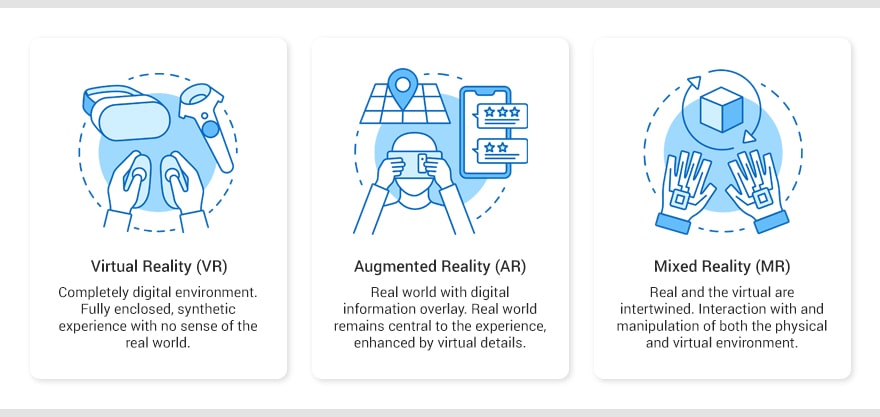With the development of technology. Here, we move on to reality such as augmented reality, virtual reality, and mixed reality. Living in the technological era means witnessing how emerging technologies are incorporated into our daily life. However, not every innovation can take root. As for augmented and virtual reality, its adoption happened so naturally and quickly that today, almost every industry enjoys the benefits of using it. So no wonder why business owners implement augmented and virtual reality solutions in order to conquer the global market.
Below are a few great examples of how each of the innovative realities — augmented, virtual or mixed — can bring your business success. But first, let’s dive into the notions!
- In Augmented reality (AR) objects are superimposed on the real-world environment in augmented reality.
- Virtual reality (VR) refers to the user in a completely synthetic environment.
- Mixed reality (MR) does more than just overlay virtual items; it also attaches them to the real world.

Extended reality (XR for short) – which encompasses virtual reality, augmented reality and mixed reality – uses technology to create more immersive digital experiences. Steam’s VR Museum of Fine Art allows users to view world-class paintings and sculptures up close – including the Mona Lisa – without fighting with crowds or protective glass.
FUTURE OF AR & VR
Virtual reality and augmented reality accomplish two very different things in two very different ways, despite the similar designs of the devices themselves. VR replaces reality, taking you somewhere else. AR adds to reality, projecting information on top of what you’re already seeing. They’re both powerful technologies that have yet to make their mark, but show a lot of promise. They can completely change how we use computers in the future, but whether one or both will succeed is anyone’s guess right now.
Thanks for your post! I also question the longevity of VR & AR, especially as it pertains to education. I see it as a novelty with an ebb and flow. I see it dying out for a bit, but when more sophisticated technology comes into play, it may come back. For now, I see it as amusement and don’t see it realistically being implemented into classroom practices. The costs are so high at the moment for VR equipment, that I cannot even fathom it being bought for school use on a large scale.
I certainly see its value though for training in a professional setting, and perhaps that’s where VR where continue to have a meaningful place.
Thank you for your post Gunpreesh. I am curious about your statement that “almost every industry enjoys the benefits of using [VR, AR, MR].” With many of these technologies only recently becoming commercially available I don’t think that the technology has the penetration and ubiquity you seem to be implying. Particularly in the context of education VR is in its relative infancy, and research is at such a preliminary stage, I think it would be premature to say we are benefiting from it as of yet. Even in a wealthy a country as Canada, I have yet to see a single practical application of immersive VR used in my school. I would concede that there are some industries where immersive technology is well established (flight simulation, labroratory simulation, industrial design), but I don’t think we can say with confidence that these technologies are a net benefit (yet).
Hi Gunpreesh,
I really like how you have broken down the definitions of AR, VR and MR. I agree that they all have the potential to be powerful pieces of technology. It is only a matter of time before we see these in different spaces. I agree with Matt’s comment above too that there are industries who are utilizing this technology (they also have the money for it) and in the future we will see what impacts AR/VR/MR will have on the education sector.
Thank-you Gunpreesh for your post!
I really liked the resource you added with some of the apps we can explore for immersive learning. I can definitely see the ways in which many science concepts could be supported, but I wonder about social studies, ELA, math, etc. and the opportunities there. I think about the presentation and the example of being interviewed as someone of a different race and the ethical and colonial issues this brings forward. Even though these technologies are exciting and engaging, there are always going to be things that can’t be taught in these ways, and continuously removing students from reality is not helping humanity, in my opinion. I really enjoyed your links and thoughts this week!